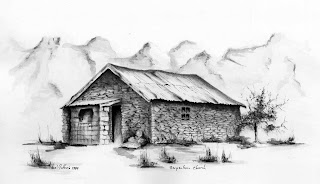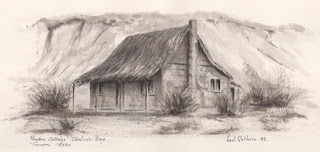An Ungodly lot at the Serpentine
Several years ago I had the opportunity to
travel over the Rough Ridge Mountain Range following part of the old Dunstan
Trail in Central Otago. It is certainly
not a trip to be taken in the latest BMW.
Even for a 4-wheel drive vehicle it was a fairly rough ride in places.
All that aside, it was a fantastic
drive. The weather was clear, with a
light easterly breeze and not a cloud in the sky, I just wished I could have
spent more time there.
Just past the Poolburn Reservoir, which in
reality is more of a small lake. We
turned left at a fork in the trail and followed the track all the way down to
the old gold diggings of the Serpentine, deep in the mountain range. At one time there was quite a settlement
there, but all that remains nowadays is the old stone Church. While there I took the opportunity to make a
quick sketch.
The site of Serpentine, as the crow flies,
is about 45 kilometres southwest from Middlemarch.
Serpentine probably began as a gold mining
township when gold was discovered there in around 1863. That shiny stuff was first located in a
little creek on the western side of the upper Taieri, near Styx Junction. Because it took a winding course across the
upper Taieri Plains, old prospectors named it the Serpentine. Although the Maori called it Waimonga, or
the Water Marrow.
Near the head of this creek, more than one
thousand metres up in Rough Ridge Range and along a small plateau, gold was
again found just prior to the winter of 1863, marking the beginnings of the
Serpentine village.
Small claims appeared in the vicinity
surrounding the township, with Long Valley, German Jacks and Pile-up,
eventually becoming the main mines.
The shallow ground at many claims was
stripped to solid rock in places within six years.
By 1869, John Cogan began blasting a
tailrace through the rock to extend his mining activities. In 1871, a tailrace being built up the
Golden Gully claim caused some legal disputes and because of this, the first
Wardens Court was scheduled to settle the affair at Serpentine. However, before the Warden, R M Robinson
arrived, matters were attended to in an out of court settlement, yes, a
solution best known to those rugged pioneers, a fist fight.
By 1872, roundabout 230 miners and others
lived around Serpentine. Europeans
numbered close to 80, while Chinese diggers, who had swarmed into the valley
over the previous couple of years or so numbered around the 150 mark. It is said the majority of the Chinese
miners avoided the extreme winters in Serpentine, they temporarily moved camp
to Moa Creek, Patearoa and Alexandra, then returning during the spring thaw.
In 1911, it is reported that ice at the
German Jacks claim was 37 centimetres thick while at Serpentine it was said to
be 50 centimetres thick.
The Mosen Brothers introduced skis made
from two metre strips of ash timber making winter travel less hazardous for
miners. The brothers owned a store in Scandinavian Gully. Unfortunately several accidents did occur
during the depths of the winter. One
reported mishap was near the Drunken Woman Inn, a pub located overland between
Serpentine and Alexandra. Here a miner
lost his life in a blizzard, and the story goes it was several years before
they found his body. During 1873, J T
Warburton, who made regular trips into Serpentine, commenced a mail
service. In that same year and to break
the monotony, a racecourse was established for the occasional event.
Towards the end of 1873, a small cemetery,
which would eventually be the last resting place of a European woman and a
young child, along with one member of the Chinese community, was
established. By 1880 it appeared the
main rush for gold was over and the little hamlet of Serpentine settled down
for a quieter life style.
Obviously Serpentine was strategically
situated for the survival of many claims in the vicinity. With two
stores-cum-hotels, it acted as the shopping centre for the miners who worked
claims like Golden Gully, Golden Link, Try Again, Golden Belt, Anglo Swiss,
Scandinavian, North Cross, Dismal Swamp, German Jacks, Long Valley and Pile-up.
While a miner’s life in Serpentine may have
been uncomplicated, it was a harsh existence. Most of the gold discovered,
usually found its way into the storekeeper’s pocket, in return for
provisions. The Chinese however, made
sure all their transactions were recorded in what they referred to as the “Big Book.”
During the 1870’s, Serpentines only church
was built of stone, with an iron roof.
However, it appears the little Church had a short but spectacular
existence. On the special day set aside
for the dedication of this little church, the minister arrived late. In the meantime, tired of waiting, miners
breasted up to the bar at the village pubs.
The service eventually got under way. Those inebriated miners caused a bit of a
kafuffle during the service, they were insisting on an encore at the end of
each hymn. Endeavouring to remain calm
throughout, the minister proclaimed at the conclusion, his parishioners were an
ungodly lot.
To the amusement of most who attended the
service, the minister scurried out of the church, claiming he was never coming
back.
Eventually, this church was sold to a
couple of miners who installed a stove thus turning the place into a place of
residence.
Much later when the valley was deserted it
became a musterer’s hut.
These days of course, the Serpentine is but
a memory, where mounds of stone and sod indicate the existence of those homes
where once a hardy breed of men and women lived.
In 1930, a distant memory drew a young
woman into these rugged mountains, back to the gravesite of a grandmother she
never knew. Here she planted a solitary
daffodil bulb.
I am told, at the onset of spring and if you
look hard enough, you may find that solitary daffodil still bringing forth a
small splash of colour, to this otherwise desolate spot.



Comments
Post a Comment